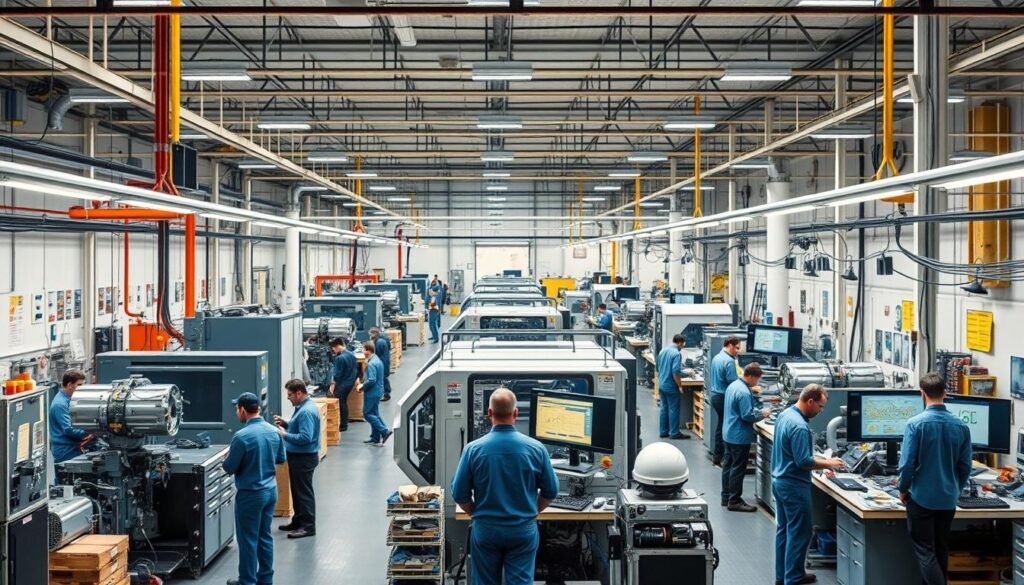Did you know that companies that effectively implement Total Productive Maintenance (TPM) can see a reduction in machinery downtime by up to 50%? This staggering statistic not only underscores the impact of TPM but also highlights its critical role in the quest to maximize efficiency across industries.
Total Productive Maintenance is more than just a maintenance strategy—it’s a holistic approach aimed at improving operational efficiency. By adopting TPM practices, organizations can enhance productivity and create a culture that prioritizes equipment reliability. As we delve deeper into this topic, we will explore the principles and benefits of TPM, revealing how it empowers teams to actively participate in maintaining their tools and processes. For a comprehensive guide on this subject, you can click here.
Key Takeaways
- TPM emphasizes a preventive maintenance approach to prevent equipment failures.
- Implementing TPM can significantly enhance productivity and efficiency.
- Employee involvement is crucial for the success of TPM initiatives.
- Operational improvements can lead to a substantial reduction in equipment downtime.
- A well-structured TPM strategy can align maintenance efforts with business goals.
- Training and continuous learning are vital components of successful TPM programs.
What is Total Productive Maintenance (TPM)?
Total Productive Maintenance, commonly referred to as TPM, represents a comprehensive approach aimed at enhancing productivity through proactive and preventive maintenance strategies. This method underscores the importance of involving every employee in the maintenance process to ensure that equipment operates at peak efficiency.
Definition of TPM
The definition of TPM revolves around the idea that all employees, not just maintenance teams, share the responsibility of upkeep and enhancement of equipment. This Total Productive Maintenance concept seeks to maximize equipment effectiveness by focusing on eliminating downtime, improving quality, and fostering a culture of continuous improvement within the organization.
History and Evolution of TPM
The history of TPM traces back to the 1960s in Japan, where companies like Toyota pioneered these practices. Initially introduced as a means to maintain machinery and reduce waste, TPM has undergone significant evolution over the decades. It has transformed from a basic maintenance approach into a critical strategy for manufacturing excellence. Today, organizations across various industries have adopted the principles of TPM, recognizing its potential to drive efficiency and operational success.
Key Principles of TPM
Total Productive Maintenance (TPM) aims to optimize manufacturing efficiency through a set of foundational principles. Grasping these TPM principles is crucial for entities aiming to bolster their maintenance methodologies.
Focus on Prevention
Prevention stands as a pivotal element within TPM. The adoption of robust prevention strategies is instrumental in curtailing equipment malfunctions. Through the execution of routine inspections, scheduled upkeep, and employee training, a culture centered on equipment dependability can be cultivated. Such practices significantly diminish the likelihood of unforeseen downtime, thereby enhancing operational efficiency.
Employee Involvement
Employee participation in TPM is a critical tenet. Engaging employees in maintenance activities promotes a sense of responsibility and capitalizes on their specialized knowledge. When employees are recognized and empowered to contribute to TPM endeavors, their motivation to maintain equipment effectively surges. Establishing transparent communication channels and feedback mechanisms enables the workforce to impart valuable insights, facilitating the refinement of processes and outcomes.
Continuous Improvement
Continuous enhancement in maintenance practices is the bedrock of operational superiority. Entities must cultivate a culture of perpetual improvement, where feedback, data analysis, and collective efforts propel process refinement. The adoption of systematic methodologies for assessment and adjustment spurs teams to pursue elevated performance benchmarks. For further insights, entities can refer to this link, which offers comprehensive guidance on TPM implementation.
Benefits of Implementing TPM
Total Productive Maintenance (TPM) introduces a plethora of advantages, significantly elevating operational performance. Organizations witness substantial enhancements across pivotal areas post-TPM adoption. Grasping these TPM implementation benefits is imperative for any entity seeking to augment productivity and employee contentment.
Increased Equipment Efficiency
The most pronounced TPM implementation benefit lies in the enhancement of equipment efficiency. Through meticulous maintenance, potential malfunctions are preemptively addressed, ensuring machinery operates at peak performance. This preemptive strategy culminates in more fluid operations and a pronounced increase in productivity.
Reduced Downtime
Minimizing downtime is paramount for any enterprise. TPM enables a systematic maintenance methodology, tackling issues proactively to avert substantial operational disruptions. Consequently, businesses experience minimal downtime, leading to amplified outputs and a robust financial performance.
Enhanced Employee Morale
TPM integration significantly boosts employee morale within maintenance roles. Employees, through continuous improvement efforts, directly contribute to tangible outcomes, fostering a sense of responsibility and pride. This environment not only elevates job satisfaction but also promotes interdepartmental cooperation.
In summary, TPM implementation catalyzes transformative outcomes, including augmented equipment efficiency, diminished downtime, and elevated employee morale. Entities striving for superior performance must consider these critical benefits when assessing their maintenance methodologies.
The Pillars of TPM
To effectively implement Total Productive Maintenance (TPM), it is essential to understand its fundamental pillars. These pillars—autonomous maintenance, planned maintenance, and quality maintenance—create a robust framework that fosters a proactive maintenance culture. Each pillar plays a critical role in maintaining equipment efficiency and ensuring product quality, making it easier to achieve organizational goals.
Autonomous Maintenance
Autonomous maintenance encourages operators to take ownership of daily maintenance tasks. By empowering employees with the responsibility for their equipment, companies can identify and address minor issues before they escalate into major problems. This practice not only enhances engagement but also builds a sense of accountability among staff, ultimately improving overall equipment effectiveness.
Planned Maintenance
Effective planning maintenance strategies are crucial for preventing breakdowns and minimizing downtime. Planned maintenance involves scheduling routine inspections and repairs based on equipment usage and manufacturer recommendations. This proactive approach ensures that machines operate at peak performance, reducing unexpected failures and extending their lifespan.
Quality Maintenance
Quality assurance in TPM focuses on ensuring that products meet established standards throughout the manufacturing process. By integrating quality checks into maintenance routines, businesses can detect defects early and improve product consistency. This pillar not only enhances customer satisfaction but also drives continuous improvement initiatives by fostering a culture of excellence.
Assessing Current Maintenance Practices
Engagement in the assessment of maintenance practices precedes the implementation of Total Productive Maintenance (TPM). This preliminary evaluation is foundational, enabling the identification of existing weaknesses. Such insights are pivotal for targeted enhancements, thereby augmenting the efficacy of TPM strategies.
Identifying Weaknesses
The process of identifying weaknesses in current protocols is paramount. Several methodologies can be employed:
- Surveys among maintenance personnel to collect their perspectives.
- An examination of historical data on equipment failures and downtime.
- Utilization of checklists to assess adherence to maintenance schedules.
These approaches facilitate a thorough comprehension of prevailing challenges, thereby enabling impactful transformations.
Measuring Performance Metrics
Establishing performance metrics for TPM is indispensable for tracking progress post-implementation. Key metrics to focus on include:
- Overall Equipment Effectiveness (OEE) to gauge productivity.
- Mean Time Between Failures (MTBF) to evaluate reliability.
- Mean Time to Repair (MTTR) to assess response efficiency.
Consistent measurement of these metrics is essential for establishing a baseline for future evaluations. This ongoing assessment is critical for sustaining the continuous improvement ethos central to TPM.
Developing a TPM Strategy
The genesis of a triumphant TPM strategy lies in the establishment of a framework, meticulously crafted to align with the overarching objectives of the organization. This methodology ensures congruence with the broader business objectives, thereby laying the groundwork for the efficacious TPM strategy development.
Setting Clear Objectives
The process of setting objectives for TPM necessitates the identification of specific, quantifiable goals that serve as the compass for all TPM endeavors. Paramount objectives encompass:
- Enhancing overall equipment effectiveness (OEE) by a predetermined margin
- Decreasing maintenance expenditures through the optimization of processes
- Augmenting workforce proficiency through the implementation of targeted training initiatives
These objectives must be quantifiable and pertinent across various organizational strata. By engendering participation at every echelon, employees become integral to the TPM odyssey, thereby amplifying engagement and success metrics.
Creating a Roadmap
A meticulously designed roadmap for TPM implementation delineates a sequential pathway for organizations. This roadmap delineates requisite tasks, stipulates timelines, and allocates responsibilities. Phases are recommended as follows:
- Examination of prevailing maintenance practices and performance metrics
- Implementation of initial pilot programs to validate enhanced TPM methodologies
- Comprehensive training of personnel to ensure congruence with TPM objectives
- Periodic evaluations and adjustments based on feedback and performance metrics
Integrating these components into your strategic blueprint not only amplifies the efficacy of TPM initiatives but also solidifies a culture of perpetual enhancement. Entities aspiring to elevate their service delivery can explore avenues to merge disparate operational systems by adhering to guidelines on how to create and optimize business profiles.
Training Your Team for TPM Success
The pivotal role of effective training in the triumph of Total Productive Maintenance (TPM) initiatives cannot be overstated. It empowers teams with the requisite knowledge and skills to adeptly execute TPM methodologies. The engagement of employees in the learning process not only amplifies their comprehension but also fosters a culture of proactive maintenance within the organization.
Conducting Effective Workshops
Workshops for TPM must be meticulously crafted to offer hands-on experience, emphasizing practical applications. The inclusion of interactive components is crucial for fostering participation. Consider the following elements for the success of workshops:
- Hands-on Activities: Permit participants to engage in TPM techniques in real-time.
- Case Studies: Present successful TPM implementations to inspire and motivate employees.
- Group Discussions: Encourage collaboration by prompting teams to brainstorm solutions to maintenance challenges.
Engaging Employees in Learning
Ensuring employee engagement in TPM techniques is essential for fostering a sense of value and investment in the process. To boost this engagement:
- Make Learning Relevant: Customize training content to align with specific roles and challenges faced by employees.
- Encourage Feedback: Establish a platform for employees to share their experiences and suggestions for enhancement.
- Recognize Achievements: Celebrate milestones achieved through TPM training to reinforce positive outcomes.
Tools and Technologies for TPM
The integration of technology is crucial for the success of Total Productive Maintenance (TPM). The adoption of appropriate TPM tools and technologies significantly enhances communication, data analysis, and the overall efficiency of maintenance practices. This section delves into the premier software solutions for maintenance and mobile applications that empower teams in their TPM endeavors.
Software Solutions
Innovative software solutions for maintenance are indispensable for tracking equipment performance, scheduling maintenance tasks, and analyzing data trends. These tools empower maintenance teams to:
- Streamline work orders and manage equipment downtime.
- Analyze historical data for predictive maintenance insights.
- Facilitate team collaboration by providing a centralized platform for information sharing.
Examples of effective software solutions include SAP PM and IBM Maximo, which offer comprehensive features tailored for maintenance management. The implementation of such technology for TPM can lead to significant improvements in operational efficiency.
Mobile Applications
The advent of on-the-go technology has revolutionized how maintenance activities are conducted. Mobile apps for TPM enable teams to access information and communicate in real-time, thereby enhancing their productivity. Key advantages of mobile apps include:
- Instant access to equipment manuals and service history.
- Real-time updates on maintenance tasks and schedules.
- Improved communication among team members while in the field.
Many organizations have successfully adopted applications like Maintenance Connection and UpKeep, effectively integrating them into their TPM strategies. The utilization of such TPM tools not only boosts productivity but also supports a proactive maintenance culture.
Integrating TPM with Lean Manufacturing

The synergy between TPM and Lean manufacturing propels operational efficiency to new heights, cultivating a culture of perpetual enhancement. Lean’s ethos of eliminating waste and refining processes is complemented by TPM’s emphasis on preventive maintenance and equipment optimization. This symbiotic relationship forms a formidable platform for attaining operational supremacy.
Understanding Lean Principles
Lean principles champion efficiency by excising non-essential activities. This paradigm compels entities to scrutinize their workflows, pinpointing opportunities for enhancement. Central to lean manufacturing are:
- Create value from the customer’s perspective.
- Identify and eliminate waste in all forms.
- Streamline processes to achieve smoother workflows.
Benefits of Combining TPM and Lean
The amalgamation of TPM and Lean significantly bolsters overall performance. This fusion yields:
- Improved Equipment Performance: TPM guarantees consistent operation, aligning with Lean’s emphasis on uninterrupted flow.
- Enhanced Employee Engagement: Employee participation in TPM and Lean initiatives cultivates a sense of responsibility.
- Greater Flexibility: An integrated strategy enables swift adaptations to evolving market needs.
Overcoming Common TPM Challenges
The integration of Total Productive Maintenance (TPM) into organizational frameworks often encounters formidable obstacles, primarily rooted in resistance to change and the complexities of resource allocation. A profound comprehension of these impediments is imperative for the establishment of a thriving TPM ecosystem.
Resistance to Change
The reluctance to embrace new methodologies or systems among employees is a pervasive phenomenon, often entrenched in the organizational culture and historical experiences. To surmount this resistance, a proactive stance is necessary. Strategies aimed at employee engagement can expedite the transition process:
- Regular communication about the benefits of TPM.
- Involving employees in planning and decision-making processes.
- Providing training sessions to increase comfort with new practices.
Lack of Resources
Resource allocation in TPM frequently encounters obstacles, including scarcity of time, financial constraints, or the absence of necessary expertise. Overcoming these challenges necessitates:
- Setting realistic timelines that accommodate gradual implementation.
- Investing in training programs that upskill workers without straining budgets.
- Leveraging technology to optimize existing resources effectively.
Case Studies of Successful TPM Implementation
An examination of real-world TPM case studies unveils profound insights into efficacious strategies and quantifiable outcomes. Across diverse sectors, the implementation of TPM in manufacturing and healthcare exemplifies the efficacy of customized methodologies. These approaches have been instrumental in elevating performance and streamlining operations.
Manufacturing Sector Success
Several entities have garnered substantial benefits through the adoption of TPM in manufacturing. A preeminent automotive manufacturer, for example, initiated TPM initiatives centered on autonomous maintenance and extensive training. This endeavor notably diminished machine downtime, thereby optimizing production efficiency and augmenting overall equipment effectiveness. For entities seeking to delve deeper into such TPM case studies, specific examples are available that delineate these transformative journeys.
Healthcare Industry Examples
In the realm of healthcare, TPM case studies underscore the substantial advantages attainable within hospital environments. A renowned hospital leveraged TPM principles to enhance equipment dependability and curtail service interruptions. The outcome was a marked improvement in patient care, accompanied by a reduction in waiting times. This instance underscores the indispensable role of effective maintenance in bolstering healthcare services. Entities aspiring to emulate similar success can draw inspiration from the documented transformations within the sector.
Notably, TPM case studies serve as a treasure trove of practical wisdom for entities across all sectors aiming to integrate best practices. Given the dynamic nature of industries, the analysis of successful TPM applications remains crucial for propelling operational excellence.
Measuring the Impact of TPM

Assessing the efficacy of TPM within an organizational framework is paramount. To achieve this, a focus on specific Key Performance Indicators (KPIs) is imperative. These metrics serve as a lens through which the success of TPM initiatives can be evaluated, revealing avenues for enhancement.
Key Performance Indicators (KPIs)
The selection of KPIs is a cornerstone in the evaluation of TPM’s impact. Common metrics employed in TPM include:
- Overall Equipment Effectiveness (OEE)
- Mean Time Between Failures (MTBF)
- Mean Time To Repair (MTTR)
- Downtime Percentage
Each metric offers critical insights into equipment performance, facilitating the identification of both the robustness and vulnerabilities within TPM frameworks. The meticulous tracking of KPIs in TPM not only substantiates the efficacy of implemented strategies but also directs the trajectory of future maintenance endeavors.
Regular Audits and Reviews
In tandem with KPI analysis, the regularity of maintenance process audits and reviews is indispensable for sustained success. These evaluations are instrumental in ensuring that TPM practices remain congruent with organizational objectives. Audits typically encompass assessments of:
- Adherence to maintenance schedules
- The efficacy of employee training initiatives
- The optimization of maintenance workflows
Through the implementation of frequent audits, teams are empowered to identify and rectify process deficiencies, thereby augmenting performance. Regular reviews act as milestones, enabling organizations to refine their methodologies based on empirical data, thereby fostering continuous improvement. For a more in-depth exploration of optimizing business structures, consider perusing available resources online.
Future Trends in TPM
The trajectory of TPM is undergoing a transformative evolution, propelled by the relentless pursuit of operational excellence. Industry 4.0 is at the forefront, merging artificial intelligence, IoT, and data analytics into maintenance frameworks. This synergy enables predictive maintenance, empowering enterprises to anticipate equipment failures, thereby enhancing reliability and curtailing downtime.
Industry 4.0 and Smart Maintenance
Smart maintenance strategies are imperative for maintaining alignment with the contemporary industrial paradigm. The integration of connected devices and intelligent monitoring systems facilitates the acquisition of real-time data and insights. This not only optimizes maintenance processes but also fortifies decision-making capabilities, ensuring readiness to proactively address maintenance challenges.
Sustainability and TPM Innovations
The integration of sustainability into TPM practices is gaining prominence, underscoring its critical role in future maintenance strategies. Organizations are now prioritizing waste reduction, energy efficiency, and resource optimization. By adopting sustainable practices, entities can contribute to environmental conservation while achieving cost savings and operational enhancements. The convergence of sustainability and advanced technology heralds a future where TPM is both efficient and environmentally conscious.
